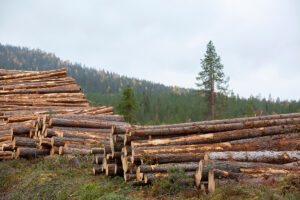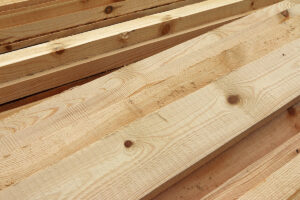
Fir, pine, Douglas fir and larch are just some of the main resinous woods, all belonging to the coniferous family. These timbers represent one of the most important natural resources used in the wood industry, to which we go further into detail in this article.
The characteristics of coniferous wood, from resistance to uses
Conifers belong to the Gymnosperm family and are trees characterised by conical, needle-shaped leaves. The timber obtained from them has a number of properties that make it valuable and ideal for a variety of applications:
- Lightness: coniferous wood is known for its lightness, a decisive factor in all contexts where weight must be carefully balanced. This characteristic makes it ideal for the construction of houses, prefabs and boats.
- Structure: coniferous wood (softwood) has a fine grain, i.e. a very narrow average growth width of the annual rings, which makes it particularly resistant and suitable for easy cutting, shaping and sanding. Coniferous wood is in fact used in the production of furniture, flooring and panelling.
- Compressive and flexural strength: although very light, coniferous wood is highly resistant to compression, which makes it particularly suitable for heavily loaded structures such as beams and pillars.
- Thermal conductivity: the low thermal conductivity of softwood results in good thermal insulation, which is why it is also the ideal wood for the production of window frames.
- Durability: with proper maintenance, softwood is perfectly resistant to weathering and the action of insects, fungi and mould.
All of these characteristics can be improved through chemical and heat treatments, and wood drying systems meet precisely these requirements. Once treated and processed, softwood can be used in a wide range of applications:
- Building construction: in the building industry, softwood is the ideal material for the construction of beams, frames, pillars, flooring and cladding;
- Furniture and design: the versatility of use and ease of processing make softwood perfect for furniture production;
- Packaging: the high compressive strength makes softwood ideal for the production of crates and pallets for transporting goods;
- Energy production: some resinous wood species are used as biomass for energy production.
In conclusion, softwood is a versatile and valuable resource due to its unique characteristics and wide range of uses. Its light weight, strength and ease of processing make it a popular choice in many manufacturing contexts, from construction to furniture, from packaging to power generation.

Differences between conifers and hardwood
Conifers are often associated (and confused) with another large family of plant species: broad-leaved (hardwood). However, they differ mainly in the type of leaves, physiology and the type of timber produced from them.
Conifers
Conifers are mostly tall plants that can exceed 100 metres in height. They get their name from the needle-like, scaly structure of their foliage, which enables them to withstand even the harshest and driest climates. The leaves are in fact perennial and, with the exception of a few species, tend to persist over time without falling in winter. Their fruits are the classic pine cones or strobiles, inside of which are the ‘naked’ seeds from which they take their name ‘gymnosperms‘ (literally ‘naked seed’).
Growing in height, conifers take on the classic triangular shape, but there are also species such as juniper and dwarf pine that have the shape of a shrub and grow in width. The combination of all these characteristics results in a simple, uniform wood structure with long fibres, making it ideal for uses such as building construction and papermaking. Softwood is generally very light, strong and has a very low density.
Hardwood
Broad-leaves have almost opposite characteristics to conifers. We are talking about the most widespread trees and shrubs in the world, whose origins are much older than the needle-shaped leaves. The first major difference to the latter lies in the leaves, which are no longer wedge-shaped but very large and developed. Although there are broad-leaf trees with perennial foliage, most species tend to fall in the winter season. The seeds are contained and protected within the fruits following the transformation of the flowers, which is why broad-leaf trees belong to the ‘Angiosperm‘ (literally ‘protected seed’) family.
Compared to conifers, hardwood has a more complex structure. It is characterised by shorter fibres and an abundance of vessels for transporting water and nutrients. For these reasons, the wood obtained from them is particularly suitable for fine carpentry work, such as the production of furniture and musical instruments.
Our solutions for the heat treatment of softwood
At Incomac, we have developed and designed drying systems suitable for treating any wood species. Our solutions can be tailor-made to the client’s specific needs, offering a wide range of choices between feeding method and drying process. In addition, our research and development department is constantly devising new technologies to improve the functionality and performance of our systems, with the ultimate goal of optimising consumption and processes, and reducing environmental impact.
For the treatment of resinous and hardwoods, we boast a wide range of systems:
- ICD conventional drying: supplied with thermal fluid, the wood is heated by heat exchangers with bimetallic finned tubes. The air exchange takes place by means of motorised dampers.
- TAG conventional drying: heating is direct, with no need for an external boiler as the kilns already include a burner. This solution is a perfect balance between performance and fuel efficiency.
- IDV conventional drying: heating takes place by means of a viscous dissipation process, i.e. generating thermal energy through the air velocity generated by the fans.
- MAC condensation drying: heating takes place by means of a heat pump, for full exploitation of the machine’s refrigeration system while reducing energy consumption.
In addition to these main solutions, at Incomac we have also developed systems for the pre-treatment of wood, steaming systems and high temperature treatment in compliance with ISPM15. The experience and professionalism of our teams also enable us to devise and design special systems that can be adapted to any sector and requirement.
Get in touch with us: we are ready to find the best solution for your business!
